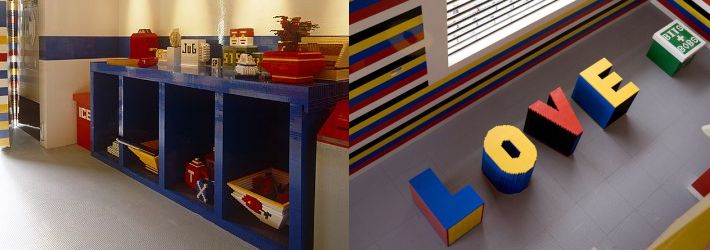Whilst Philip Corsius has made a hobby out of making small Lego figures, designer Christina Fallah has gone from one extreme to the other as she was involved in a huge Lego project.
In 2009, as part of James May’s Toy Stories series, a Lego house was created. It was two-storeys tall, built by a thousand volunteers and consisted of 3.5 million bricks. Unfortunately the house was demolished quite soon after completion because a new owner could not be found.
The fiddly decorative parts of the house were the responsibility of interior designer Christina Fallah, who is used to more conventional projects.
She was approached by the BBC, as were many other designers, about the job: “I was called in and of course arrived in a rush. Their first question to me was ‘How do you see a life sized Lego House?’ I answered Mondrian, Cubism, Modernism, and the like and moved my hands a lot! That night they rang me and said I had got the job!”
Despite having to work with a product that it is not intended for creating a life-size house, Christina did not see it as a huge leap from her previous work: “Each project is different, and many of the projects I have been lucky enough to do, haven’t been done before. So this particular project wasn’t that different really. Fear of failure doesn’t exist when you have passion for design. Ignorance is therefore bliss!
“For instance I was asked to design and build a glass floor that drops onto a pool [called the Dublin project] so I used the philosophy that anything is possible. I think that is because I hadn’t worked with Lego before, nor had a project like this been done before, I designed it from a child’s perspective. Everything was designed so that it would be instantly recognisable.”
Lego is not the easiest of products to use, especially on such an intricate and grand scale. On top of this Christina confessed that as a child she never much played with Lego, preferring her dolls over it. Despite this lack of knowledge she was a quick and keen learner: “The more you work with it, first with your hands and then you sketch, draw and figure and count it all out, the better you get at it.
“It’s sort of similar to learning how to drive, or ride a bicycle. You never forget how to do it, but learning it at the outset and designing large pieces of furniture and a house, when there is no set right or wrong way of doing things, makes you actually build and see things in 3D. So in reality you need to have an imagination and be able to visualise things. That’s why kids are so good at it. They see things as they really are, without thinking about it too much.”
Christina was extremely happy with the final result: “I was thrilled and exhausted. I had such a wonderful experience spending the summer with the volunteers and designing this project that it was rather sad at the end, as the process itself was very intense.
“I am sure I drove everyone round the bend during the project, but like everyone else, I was thrilled to be involved and was delighted with the end result. It ended up being just as I had imagined it, and I also believe James in the end was like a kid in a toy shop!”

Leave a Reply